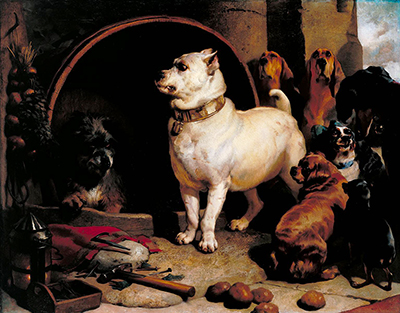Alexander and Diogenes is an oil on canvas painting which was exhibited in 1848 in London. Alexander and Diogenes depict several different breeds of dogs as the main subject. A short white dog occupies the central position and is what draws the attention of the viewers first in the painting.
The white dog is staring fiercely at the left side of the paint and this creates a mysterious effect on the admirer of the picture to be curious to know more of what is been looked at by the dogs. A golden brown shorter dog, besides the white attractive dog, with longer hair, is seen resting on the floor. Tools in the paint, Alexander and Diogenes, are seen scattered on the floor and a lantern left on the foreground and there is a group of bigger dogs at the right, with two basset hounds. The paint, Alexander and Diogenes, has a rich mix of colors that are artificial, cool and harmonious. The viewer's eyes are first attracted by the central white dog, then to a smaller one with white patches too on its neck, then to the three golden brown dogs and finally the darker ones.
The elements in the picture Alexander and Diogenes are arranged in the middle and back ground in the paint. Most are overlapping with the exception of the main subject, the white dog. The atmosphere or mood of the paint is energetic and thought-provoking. The lighting in the paint is from an artificial source,side-lit and casts dark shadows of the features in the picture. It varies from bright to dim, and warm lighting in the background.
John Landseer studied under several artists who had a great profound influence on his work. They include his father who was an engraver, and the famous history painter Robert Haydon who encouraged Landseer in performing dissections so as to fully understand the animal musculature and skeletal structure. Some of edwin Henry Landseers work include The Hunting of Chevy Chase 1825 to 1826, An Illicit Whisky Still in the Highlands 1826 to 1829, The Monarch of the Glen 1851, Rent Day in the Wilderness 1855 to 1868, off to the Rescue 1827, A Distinguished Member of the Humane Society 1838 and Saved 1856.




